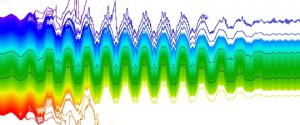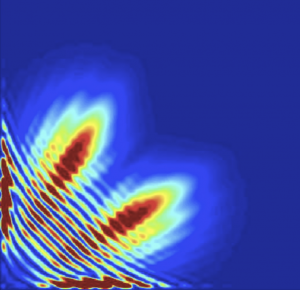Research Theme
Photons, Electrons and Quantum Mechanics
Matter is made up of molecules. A molecule is made up of atoms. It is electrons that bond atoms in molecules and trigger chemical reactions. Electrons transmit information in electronic devices and living organisms. Electrons transform light into chemical energy in photosynthesis. Light shakes electrons to initiate dynamics. In return, electrons emit new light as they move. Ishikawa Laboratory theoretically studies the interaction between light and electrons in atoms and molecules using the ab-initio simulations (first-principles simulations, first-principle simulations) based on quantum mechanics.
Atoms and Molecules in Intense Laser Fields

Electron shaken by a strong laser field. It is partially ejected from the molecule.
Atoms and molecules irradiated by high-intensity femtosecond laser pulses exhibit extremely nonlinear behavior, such as tunneling ionization and high-harmonic generation. Using these so-called “high-field phenomena,” we can find out how electrons move in the attosecond (=0.000000000000000001
second!) time scale and extract information on rare events such ultrafast change in molecular structure and chemical bonding.
There is thus rapidly increasing interest in high-harmonic generation and tunneling ionization as a new tool for ultrafast spectroscopy. On the other hand, a major obstacle is difficulty in proper interpretation of experimental results. Therefore, theoretical development is highly expected to overcome the barrier. Simulations of atoms and molecules in intense laser fields are a big challenge. We need to consider many excited states and spatially spread continuum states. Electrons interact not only with light but also between electrons themselves.
Our laboratory has recently developed a new simulation method that will open a way to the first-principles theoretical study of intense-field-induced ultrafast phenomena in realistic atoms and molecules. Our development is creating a new stream in theoretical study of atoms and molecules in intense laser fields.
Electronic Motion Revealed by Femtosecond and Attosecond Laser Pulses

Double ionization of a helium atom induced by an attosecond XUV pulse
Recent progress in high-harmonic generation and free electron laser techniques has enabled the production of femtosecond and attosecond pulses in the extreme ultraviolet (XUV) and soft x-ray spectral ranges. XUV and soft x-ray pulses induce ionization and core excitation of atoms and molecules. Until recently, ionization was considered to take place just instantaneously. However, with the advent of attosecond laser, we can now capture electronic motion following photoabsorption like an ultrashort movie played in slow motion. Furthermore, how the other electrons behave after ionization and core excitation is the key to understand DNA damage caused by radiation, photosynthesis, solar cell (photovoltaic cell), chemical reactions, etc.
Our theoretical studies, notably our first-principles simulations also help our experimentalist collaborators to understand their measurement results better. We even suggest new experiments.
